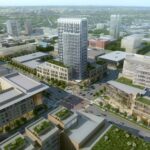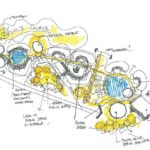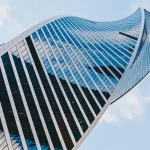The Chemical Bio-Synthesis of Architecture, Architectural Theory, Buildings
The Chemical Bio-Synthesis of Architecture
Architectural Discussion by Ian K Whittaker
4 Nov 2013
The Chemical Bio-Synthesis of Architecture Article
Article by Ian K Whittaker
The Chemical Bio-Synthesis of Architecture – Discussion
What Architecture was
The Ancestor forms of Architecture used the Earths materials, resources, energy and environment to create prestige on a global scale.
This Classical Materialist Architecture considered that all that was needed was the correct arrangement of matter to create beauty.
The Hylomorphistic theory took materialism and split it into matter and form with an external spark of vital energy.
The Vitalism theory perpetuated the external ‘vital spark’ theory.
Through the examinations of the sciences of Chemistry, Philosophy and Anatomy the difference between the inorganic and the organic, then between the living and the non-living, then the principle of life were examined. It was established that Life did not need an external ‘vital force’ to be created.
Life only needed the principles of Chemistry to be created since within those principles lie all of the potential energy and resources of the Universe.
Architecture following this scientific enlightenment remained dedicated to serving the needs of humanity by the provision of prestige and functionalism. It used the increasing amount of products of the new industrial age and it gave little consideration for the effects on the environment and resource levels of the Earth.
What Architecture is now
Ecology; one of the Biological Sciences; on being applied to society caused changes in cultures, appreciations of beauty and quality, changes to values and so redefinitions of human needs that allowed for protecting the environment, resources and energy of the Earth.
It has been established that the materials, resources, energy and environment of the Earth are depleting. Manufacturing will also deplete with the reduction in energy and resources.
Architecture is responding to these influences and so changing its original Materialist nature.
What Architecture needs to be
Architecture needs to acknowledge the technological abilities of the age it exists in and to disconnect itself from the outdated, stylistic, materialistic influences of history.
Architecture needs to become the living materials, resources, energy and the environment.
It needs to organize itself to become an instrument of the environment.
An Organon. An Individual Organism each time it is created.
Architecture needs to retain its links to the sciences and establish a new link to the environment to overcome the depletion of natural resources by creating new resources energy and environment.
Architecture needs to become a set of chemical reactions into the environment.
Architecture needs to become a Chemical Bio-Synthetic creation.
A Life Form is a set of chemical reactions to the environment.
If Architecture can organize itself, metabolize, achieve homeostasis, allow for adaptation, respond to stimuli, reproduce, grow, die and be recycled then it will be considered a Life Form.
Therefore in the future age of depletion Architecture needs to become a Chemical Bio-synthetic Life Form.
This no small undertaking. It proposes Architecture become part of the most complicated process in the Universe.
If it is to be accomplished then a pattern for the Chemical Bio-Synthesis of Architecture must be established.
This is an initial specification for that new Chemical Bio-synthetic Life Form.
The Chemical Bio-Synthesis of Architecture – Article by Ian K Whittaker
Process
The proposed method of formation is Chemical Bio-synthesis in a standard open Earth type Environment.
The Activator for Chemical Bio-synthesis is the change in environmental equilibrium.
This is assumed to be temperature and density of materials resulting in a chemical mass change per unit area and associated energy to mass chemical reaction either exothermically, outward to the surroundings or endothermically, energy taken in from the surroundings.
The initial destabilizing energy being electromagnetic in nature.
The interchange being at an electron level altering the chemical bonds of the elements involved.
In this respect the Carbon base is vital in that it allows multiple bonds for each of the necessary chemical bio-synthetic elements to form hydrocarbons and so chemical reactions with the environment.
Chemical Base 001
The Architecture must be a carbon base Chemical Bio-synthetic Life Form in order to allow it to chemically bond and disconnect at an atomic level with Oxygen Hydrogen and Nitrogen.
C12 + O2 + H2 + N
Chemical Base 002
The Architecture must chemically bond and disconnect at an atomic level with Oxygen Hydrogen and Nitrogen to form Amino Acids.
C12 + O2 + H2 + N = -NH2 Amine is an example of this chemical level.
C12 + O2 + H2 + N = -COOH Carboxylic Acid is an example of this chemical level.
Chemical Base 003
The Architecture must chemically bond and disconnect at an atomic level with Oxygen Hydrogen and Nitrogen to form 22 Proteinogenic, precursor protein building, amino acids.
CH3CH(NH2)COOH Alanine is an example of this chemical level.
Chemical Base 004
The Architecture must harvest energy by the oxidation of organic or inorganic materials in their environments in a Heterotrophic or Chemotroph bacteria method.
C106H263O110N16P Seawater Algae is an example of this chemical level.
C5H7O2N a chemical microbial bio-mass is an example of this chemical level.
C6H12O6 + 6O2 → 6CO2 + 6H2O + energy is an example of the oxidation of glucose.
Environment
The environment for the initial reaction is to be in a shallow mixing pool with a semi-porous surface boundary, with salt or fresh water, of ph level 6 to 6.8, with heat, with light, with air flow, with day and night conditions, with organic donor materials present.
Pressure
The pressure for the initial reaction is to be 101325 Pa at 288.15 K, 15 deg C, Earth normal surface pressure at sea level outside the mixing pool area. Within the mixing pool area the pressure is to be variable by one tenth earth normal surface pressure at sea level.
Temperature
The temperature for the initial reaction is to be between 50°C 122 °F to 110 °C 230 °F.
Chemical energy sources or light sources may also be used.
Heterotrophic and Chemotroph bacteria Donor
The preferred donor for the Heterotrophic bacteria; an organism that cannot chemically alter carbon into organic molecules; is a millilitre of salt water.
The preferred donor for the Chemotroph bacteria; an organism that can chemically alter carbon into organic molecules; is a millilitre of fresh water.
Both the salt and fresh water should, as a standard, contain a million bacterial cells.
Metabolism
The preferred anabolic donor material for energy is carbon dioxide since this allows the synthesis of organic compounds.
Decomposing organic matter from previous Architecture may also be used through catabolism.
Chloroplast synthesis of light energy, photosynthesis, may also be used.
6CO2 + 6H2O → plus exposure to electromagnetic radiation, light → C6H12O6 + 6O2 + energy
Carbon Dioxide + water plus exposure to electromagnetic radiation gives glucose + oxygen
Source: BBC
Mitochondria synthesis relating to respiration may also assist.
C6H12O6 + 6O2 → 6CO2 + 6H2O + energy
Glucose + oxygen gives out carbon dioxide + water vapour + energy
Source: BBC
Organization
The Architecture must be unicellular and become multicellular.
The Architecture must begin as a Prokyrote, it must not have a membrane bound nucleus.
The Ribosomes of the Architecture, the chemical synthesis locations of proteins, are to be composed of a donor protein and RNA Ribonucleic acid. Its proteins, DNA, Dioxiribonucleic acid, and metabolites are all to be water soluble.
Development may be by gene copying. DNA transfer via. water medium.
Through Endosymbiosis the Eurokyrote stage of the Architecture must have a membrane bound nucleus to contain the DNA of the previous Prokyrote and the Eurokyrote and allow for mutual replication.
The Architecture must have multiple bacterial Prokaryotes for energy storage and for the breaking down and reassembling of the DNA and environmental nutrients.
Homeostasis
The Architecture must undergo metabolism, reproduction through chemical, enzyne catalyse reactions.
The Architecture must maintain homeostasis, the control of its acidity, alkalinity, and temperature both internally and externally to ensure that cellular regeneration through chemical bonding is maintained for the duration of the Architecture.
Adaptation
In this section adaptation is also considered to encompass communication, sleep; chemical regeneration; foraging for food, food identification, killing systems, digestion and excretion systems.
The Architecture must provide for a response to internal and environmental stimuli relating to temperature, resource levels, energy levels, light and dark, acidity and alkalinity, locations of growth and decay, resource intake, and refuse deposition.
Adaptation interface with the environment is initially to be via.
electrochemical stimuli of receptors in the envelope of the Architecture.
Secondary adaptation is to be via. chemical neurotransmittance to a nerve storage lattice.
Output adaptation is to be by chemical neurotransmittance to the nerve storage lattice and then to muscles and blood circulation systems to invoke a movement of the Architecture.
Nurotransmitter systems to be used
C5H9NO4
Glutamic acid neurotransmitter for learning and memory
C4H9NO2
Gama Aminobutyric Acid as a neuro inhibitor for muscle control
C7NH16O+2
Acetylcholine neurotransmitter for detection and transmission of neurosignals
C8H11NO2
Dopamine neurotransmitter for detection and transmission of neurosignals
C10H12N2O
Serotonin neurotransmitter for regulation of metabolism functions such as appetite, sleep, memory and learning, temperature, mood, behavior, muscle contraction, and function of the cardiovascular system and endocrine system.
C63H98N18O13S
Substance P neurotransmitter for detection and transmission of neurosignals related to pain detection
Opioid Peptides – such as endorphins neurotransmitter for regulation of motivation, emotion, attachment behavior, the response to stress and pain, and the control of food intake.
Source: https://en.wikipedia.org/wiki/Neurotransmitter
Digestion of carbohydrates principle to be used
Starch + water + (amylase) –> maltose
C6H10O5 + H20 –> C12 H22 O11
Maltose + water + (amylase) –> monosaccharides
Source: http://www.nygmascience.com/biology/level-3/unit-11-physiology-of-human-body-systems/11-4-the-digestive-system/
Digestion of fats principle to be used
Fat droplets + water + (lipase) –> glycerol + fatty acids.
C55H98O6 + H20 à C3H8O3 + C18H34O2
Source: http://www.nygmascience.com/biology/level-3/unit-11-physiology-of-human-body-systems/11-4-the-digestive-system/
Digestion of proteins principle to be used
Protein + pepsin – (water, condensation reaction) –> amino acids
C44189H71252N12428O14007S321 + H20 + (PEPSIN) –>C2H5NO2
Source: http://www.nygmascience.com/biology/level-3/unit-11-physiology-of-human-body-systems/11-4-the-digestive-system/
Response to stimuli
The Architecture must respond to stimuli, from the internal and external environment via sensory receptors within the Architectures envelope and also free roaming within the volume of the Architecture.
The response stimuli can be by localized chemical interaction, electrochemical interaction from the envelope via nerve lattices to muscle locations to promote a movement of the Architecture in a direction to reduce or enhance the stimulus being received such as phototropism, and chemotaxis.
The free roaming sensory receptors must identify and block all invasive Chemical Bio-synthetic Life Forms and assist the self repair systems formed by the organic compounds.
Primary electrochemical sensors located within the envelope of the Architecture relating to touch, smell, taste, sight, hearing sensors must be allowed for.
Temperature sensors must be assisted by the primary sensory receptors. A nerve cell lattice within the Architecture must store previous sensory inputs to allow checking with all current and future sensory systems to allow the Architecture to evolve.
Endogenous DNA sequences based on viruses are the preferred form of Nurotransmitter.
Nurosensors and synaptic nerve Nurotransmitters such as Serotonin must be employed throughout the nerve system lattice.
Nurotransmitter action must be linked to the environment sensor receptors to allow circadian rhythm control of the Architecture.
Nerve cell lattices are needed within all parts of the Architectures envelops with synaptic gaps to allow Neurochemical interface of the whole Architecture Neuron doctrine interchange is required to allow the Architecture to achieve a neuro feedback even during ongoing environmental changes and self monitoring.
Sodium and Calcium voltage gate systems are the preferred from of synaptic interface at each neuron in the nerve lattice.
Reproduction
The Architecture must reproduce by either asexual or sexual reproduction Mitosis, Cell division and Meosis.
Sexual reproductions are the preferred copying systems for the Architecture to match the prevailing environmental conditions.
If a problem occurs during cell division to the overall incubation matrix growing the new Architecture then the Architecture must utilize the following system to ensure maximum survival in all environmental changes.
The Architecture must have 10 times more microbes than cells at all times.
One diploid cell must have two instances of each chromosomes.
4 chromosomes of 1 diploid cell must have 4 probabilities of species variance and must have 4 haploid cells or gametes.
4 haploid of 2 chromosomes must have 8 probabilities of species variance and must have gametes of Ovum of X chromosome and Gametes of Sperm of X and Y chromosome.
The Architecture must have both an XX chromosome to produce a secondary incubating Architecture form and a XY chromosome to produce a sex determination Architecture form.
The Architecture must; through natural selection; adapt to its environment in successive generations.
All successful, unsuccessful and terminated evolutionary stages must be stored in the sensory Nurotransmitter lattice of all Architecture to avoid retrogressive evolution and failure of any new Architecture.
The Architecture must have a duration that does not reduce the resources and energy of its local environment to a depletion level.
The Architecture must monitor the deposition of its waste materials and associated decay levels in the local environment to identify when they can be reused as a resource and ingested.
Growth
The Architecture must provide for a higher rate of anabolism, energy input, than catabolism, energy output, growth more than decay, to survive.
A Colony form of chemical cellular generation nucleotide bases to assist development is to be allowed for in the early stages of the Architectures development.
The Architecture must possess a capacity to grow by photosynthesizing and absorbing, nutrients, water, light, atmospheric gases, heat, salts, sugars, glucoses.
The photosynthesis is to be accomplished by chlorophyll pigments and proteins that can absorb electromagnetic radiation in the ultraviolet and infra-red wavelengths and reflect all other light wavelengths.
The chlorophyll is to be manufactured from organic compounds containing carbon.
Maintenance
The Architecture is maintained by the intake and breaking down of Carbon, Oxygen, Hydrogen and Nitrogen, through food, air and water digestion, to reform amino acid components.
Death and Recycling
When the chemical reactions of the Architecture cannot be maintained by the Architecture then the Architecture must be allowed to reduce chemical bonding and increase its decay level by the chemicals present in the immediate environment.
In a similar manner to medical diagnosis, genetic engineering, quantum physics, chemistry, hybrid plant cultivation and recently Nanotechnology, the monitoring of the progress of the reaction once started of a Chemical Bio-synthetic Life Form Architecture would be very limited.
Therefore if a Chemical Bio-synthetic construction system is proposed for a new Architecture it must be controlled at a chemical bonding level to avoid it expanding to a Universal form by consumption. It must have an in-built ‘switch’ to reverse its evolution. The original switch is the Nitrogen cycle combined with the limited area in which the organism is developed.
Additional Issues
The Architecture of a carbon base Chemical Bio-synthetic Life Form is at its initial stages only the chemical bonding of Oxygen Hydrogen and Nitrogen around a Carbon base.
It is efficient Architecture in that it uses the minimal amount of materials, energy and environment to be created.
Once created however it uses the maximum amount of materials, energy and environment to maintain itself and to expand through growth and reproduction.
Its timescales are limited only by the longevity of its resources, energy and environmental input.
The process of chemical bio-synthesis is now possible in a laboratory situation and transferrable to the chosen environment site so the first prototypes are ready to appear and be monitored as they grow.
Conclusion
To return to the initial Need.
Our planet needs resources, energy and environment.
Architecture once fed off these three things to be created.
It is now time that it repaid those free products of the Earth.
Our technology now allows a basic understanding of the chemical Bio-synthesis processes of the Earth so we can alter the nature of Architecture to a provider and not a consumer state.
Architecture is creation.
Architecture can become a Bio-synthetic life Form that creates.
What is this new form of Architecture to be used for ?
It is for the repair of the existing eco-system of the planet.
It is for the creation of a new eco-system on any new planet humans want to colonise.
It is for the creation of organic materials and resources.
It is for the creation of an organic energy production system.
It is for the creation of an organic communications system.
It is for the creation of an organic food system.
It is for the creation of an organic water system.
It is for the maintenance of human Life and its technological development.
Ian K Whittaker
Article by Ian K Whittaker
Comments on this Chemical Bio-Synthesis of Architecture article are welcome.
Architectural Articles by Ian K Whittaker
Architectural Energy Depletion
Architectural Materials Depletion
Architectural Articles – Selection
Resisting Boredom : article by Joyce Hwang. 25 Jan 2011
Placebo Architecture : article by Karolina Szynalska – 27 Sep 2011
Nature Architecture : article by Trevor Tucker. 15 Sep 2009
Sustainable Buildings – Building Issues : article by Adrian Welch
Benbow Yard Home, Southwark, South London
Design: FORMstudio, Architects
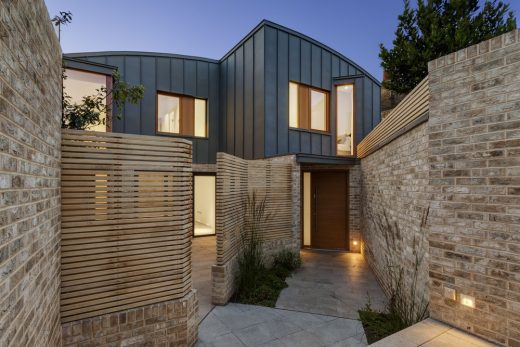
photograph © Bruce Hemming
Contemporary Home in Southwark
The Norman Foster Foundation presents its annual Digital X Workshop
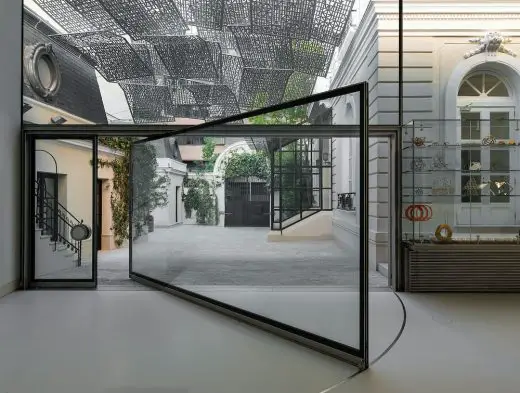
photo © Luis Asín © Norman Foster Foundation
Norman Foster Foundation Madrid
Comments / photos for the The Chemical Bio-Synthesis of Architecture – Architectural Article page welcome

